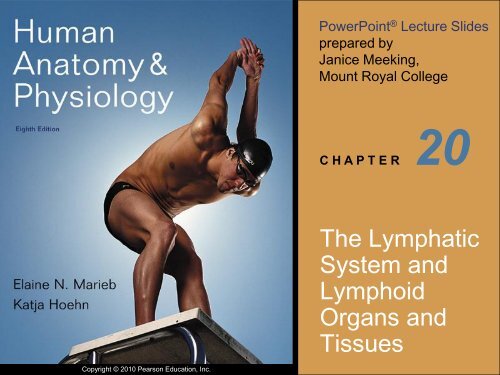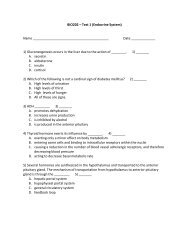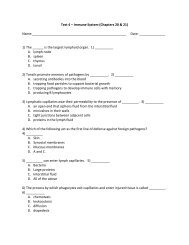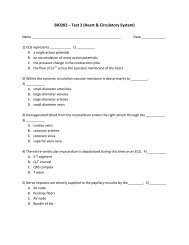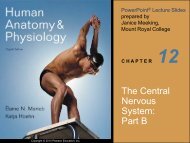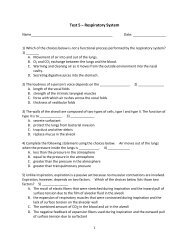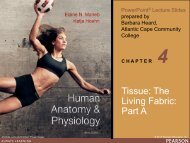The Lymphatic System and Lymphoid Organs and ... - Next2Eden
The Lymphatic System and Lymphoid Organs and ... - Next2Eden
The Lymphatic System and Lymphoid Organs and ... - Next2Eden
Create successful ePaper yourself
Turn your PDF publications into a flip-book with our unique Google optimized e-Paper software.
Copyright © 2010 Pearson Education, Inc.<br />
PowerPoint ® Lecture Slides<br />
prepared by<br />
Janice Meeking,<br />
Mount Royal College<br />
C H A P T E R<br />
20<br />
<strong>The</strong> <strong>Lymphatic</strong><br />
<strong>System</strong> <strong>and</strong><br />
<strong>Lymphoid</strong><br />
<strong>Organs</strong> <strong>and</strong><br />
Tissues
<strong>Lymphatic</strong> <strong>System</strong><br />
• Consists of three parts<br />
1. A network of lymphatic vessels<br />
(lymphatics)<br />
2. Lymph<br />
3. Lymph nodes<br />
Copyright © 2010 Pearson Education, Inc.
<strong>Lymphatic</strong> <strong>System</strong>: Functions<br />
• Returns interstitial fluid <strong>and</strong> leaked plasma<br />
proteins back to the blood<br />
• Once interstitial fluid enters lymphatics, it<br />
is called lymph<br />
• Together with lymphoid organs <strong>and</strong> tissues,<br />
provide the structural basis of the immune<br />
system<br />
Copyright © 2010 Pearson Education, Inc.
Copyright © 2010 Pearson Education, Inc.<br />
Venous system Arterial system<br />
Heart<br />
<strong>Lymphatic</strong><br />
system:<br />
Lymph duct<br />
Lymph trunk<br />
Blood<br />
capillaries<br />
Lymph node<br />
<strong>Lymphatic</strong><br />
collecting vessels,<br />
with valves<br />
Filaments anchored<br />
to connective tissue<br />
Endothelial cell<br />
Flaplike minivalve<br />
Fibroblast in loose<br />
connective tissue<br />
<strong>Lymphatic</strong><br />
capillary<br />
Tissue<br />
fluid<br />
Tissue cell Blood<br />
capillaries<br />
<strong>Lymphatic</strong><br />
capillaries<br />
(a) Structural relationship between a<br />
capillary bed of the blood vascular<br />
system <strong>and</strong> lymphatic capillaries.<br />
(b) <strong>Lymphatic</strong> capillaries are blind-ended tubes in which<br />
adjacent endothelial cells overlap each other,<br />
forming flaplike minivalves.<br />
Figure 20.1
<strong>Lymphatic</strong> Vessels<br />
• One-way system, lymph flows toward the<br />
heart<br />
• Lymph vessels (lymphatics) include:<br />
• <strong>Lymphatic</strong> capillaries<br />
• <strong>Lymphatic</strong> collecting vessels<br />
• <strong>Lymphatic</strong> trunks <strong>and</strong> ducts<br />
Copyright © 2010 Pearson Education, Inc.
<strong>Lymphatic</strong> Capillaries<br />
• Similar to blood capillaries, except<br />
• Very permeable (take up cell debris,<br />
pathogens, <strong>and</strong> cancer cells)<br />
• Endothelial cells overlap to form one-way<br />
minivalves, <strong>and</strong> are anchored by collagen<br />
filaments, preventing collapse of capillaries<br />
Copyright © 2010 Pearson Education, Inc.
<strong>Lymphatic</strong> Capillaries<br />
• Absent from bones, teeth, bone marrow <strong>and</strong><br />
the CNS<br />
• Lacteals: specialized lymph capillaries<br />
present in intestinal mucosa<br />
• Absorb digested fat <strong>and</strong> deliver fatty lymph<br />
(chyle) to the blood<br />
Copyright © 2010 Pearson Education, Inc.
Filaments anchored<br />
to connective tissue<br />
Endothelial cell<br />
Flaplike minivalve<br />
Fibroblast in loose<br />
connective tissue<br />
(b) <strong>Lymphatic</strong> capillaries are blind-ended tubes in which<br />
adjacent endothelial cells overlap each other,<br />
forming flaplike minivalves.<br />
Copyright © 2010 Pearson Education, Inc.<br />
Figure 20.1b
<strong>Lymphatic</strong> Collecting Vessels<br />
• Similar to veins, except<br />
• Have thinner walls, with more internal valves<br />
• Anastomose more frequently<br />
• Collecting vessels in the skin travel with<br />
superficial veins<br />
• Deep vessels travel with arteries<br />
• Nutrients are supplied from branching vasa<br />
vasorum<br />
Copyright © 2010 Pearson Education, Inc.
<strong>Lymphatic</strong> Ducts<br />
• Lymph is delivered into one of two large<br />
ducts<br />
• Right lymphatic duct drains the right upper<br />
arm <strong>and</strong> the right side of the head <strong>and</strong><br />
thorax<br />
• Thoracic duct arises from the cisterna chyli<br />
<strong>and</strong> drains the rest of the body<br />
• Each empties lymph into venous<br />
circulation at the junction of the internal<br />
jugular <strong>and</strong> subclavian veins on its own<br />
side of the body<br />
Copyright © 2010 Pearson Education, Inc.
Internal jugular vein<br />
Entrance of right<br />
lymphatic duct into vein<br />
Entrance of thoracic<br />
duct into vein<br />
Thoracic duct<br />
Cisterna chyli<br />
<strong>Lymphatic</strong><br />
collecting vessels<br />
Copyright © 2010 Pearson Education, Inc.<br />
Aorta<br />
Regional<br />
lymph nodes:<br />
Cervical nodes<br />
Axillary nodes<br />
Inguinal nodes<br />
Drained by the right<br />
lymphatic duct<br />
Drained by the<br />
thoracic duct<br />
(a) General distribution of lymphatic collecting vessels<br />
<strong>and</strong> regional lymph nodes.<br />
Figure 20.2a
Right jugular trunk<br />
Right lymphatic duct<br />
Right subclavian trunk<br />
Right subclavian vein<br />
Right broncho-<br />
mediastinal trunk<br />
Brachiocephalic veins<br />
Superior vena cava<br />
Azygos vein<br />
Cisterna chyli<br />
Right lumbar trunk<br />
Copyright © 2010 Pearson Education, Inc.<br />
Internal jugular veins<br />
Esophagus<br />
Trachea<br />
Left subclavian trunk<br />
Left jugular trunk<br />
Left subclavian vein<br />
Entrance of thoracic<br />
duct into vein<br />
Left bronchomediastinal<br />
trunk<br />
Ribs<br />
Thoracic duct<br />
Hemiazygos vein<br />
Left lumbar trunk<br />
Inferior vena cava<br />
Intestinal trunk<br />
(b) Major lymphatic trunks <strong>and</strong> ducts in relation to veins <strong>and</strong><br />
surrounding structures. Anterior view of thoracic <strong>and</strong> abdominal wall.<br />
Figure 20.2b
Lymph Transport<br />
• Like blood in the veins, lymph is propelled<br />
by<br />
• Pulsations of nearby arteries<br />
• Contractions of smooth muscle in the walls<br />
of the lymphatics<br />
• Respiratory movement<br />
Copyright © 2010 Pearson Education, Inc.
<strong>Lymphoid</strong> Cells<br />
• Lymphocytes the main warriors of the<br />
immune system<br />
• Two main varieties<br />
• T cells (T lymphocytes)<br />
• B cells (B lymphocytes)<br />
Copyright © 2010 Pearson Education, Inc.
Lymphocytes<br />
• T cells <strong>and</strong> B cells protect against<br />
antigens<br />
• Anything the body perceives as foreign<br />
Copyright © 2010 Pearson Education, Inc.<br />
• Bacteria <strong>and</strong> their toxins; viruses<br />
• Mismatched RBCs or cancer cells
Lymphocytes<br />
• T cells<br />
• Manage the immune response<br />
• Attack <strong>and</strong> destroy foreign cells<br />
• B cells<br />
• Produce plasma cells, which secrete<br />
antibodies<br />
Copyright © 2010 Pearson Education, Inc.
Other <strong>Lymphoid</strong> Cells<br />
• Macrophages phagocytize foreign<br />
substances <strong>and</strong> help activate T cells<br />
• Dendritic cells capture antigens <strong>and</strong><br />
deliver them to lymph nodes<br />
• Reticular cells produce stroma that<br />
supports other cells in lymphoid organs<br />
Copyright © 2010 Pearson Education, Inc.
Copyright © 2010 Pearson Education, Inc.<br />
Macrophage<br />
Reticular cells on<br />
reticular fibers<br />
Lymphocytes<br />
Medullary sinus<br />
Reticular fiber<br />
Figure 20.3
<strong>Lymphoid</strong> Tissue<br />
• Largely composed of a type of loose<br />
connective tissue called reticular connective<br />
tissue<br />
• Houses <strong>and</strong> provides a proliferation site for<br />
lymphocytes<br />
• Furnishes a surveillance vantage point<br />
• Two main types<br />
• Diffuse lymphatic tissue<br />
• <strong>Lymphatic</strong> follicles (lack a capsule, may<br />
contain germinal centers for Ab production)<br />
Copyright © 2010 Pearson Education, Inc.
<strong>Lymphoid</strong> Tissue<br />
• Diffuse lymphatic tissue comprises scattered<br />
reticular tissue elements in every body organ<br />
• Larger collections in the lamina propria of<br />
mucous membranes <strong>and</strong> lymphoid organs<br />
Copyright © 2010 Pearson Education, Inc.
<strong>Lymphoid</strong> Tissue<br />
• <strong>Lymphatic</strong> follicles (nodules) are solid,<br />
spherical bodies of tightly packed reticular<br />
elements <strong>and</strong> cells<br />
• Lack a capsule<br />
• Germinal center composed of dendritic <strong>and</strong><br />
B cells<br />
• May form part of larger lymphoid organs<br />
Copyright © 2010 Pearson Education, Inc.
<strong>Lymphoid</strong> <strong>Organs</strong><br />
• Lymph nodes are just one example of the<br />
many types of lymphoid organs<br />
• Spleen<br />
• Thymus<br />
• Tonsils<br />
• Peyer’s patches<br />
• Common feature is they are composed of<br />
reticular connective tissue<br />
Copyright © 2010 Pearson Education, Inc.
Lymph Nodes<br />
• Principal lymphoid organs of the body<br />
• Embedded in connective tissue, in clusters<br />
along lymphatic vessels<br />
• Near the body surface in inguinal, axillary, <strong>and</strong><br />
cervical regions of the body<br />
• Key point: lymph nodes filter lymph -- only<br />
lymph nodes have afferent <strong>and</strong> efferent<br />
connections to the lymphatic vessels<br />
Copyright © 2010 Pearson Education, Inc.
Internal jugular vein<br />
Entrance of right<br />
lymphatic duct into vein<br />
Entrance of thoracic<br />
duct into vein<br />
Thoracic duct<br />
Cisterna chyli<br />
<strong>Lymphatic</strong><br />
collecting vessels<br />
Copyright © 2010 Pearson Education, Inc.<br />
Aorta<br />
Regional<br />
lymph nodes:<br />
Cervical nodes<br />
Axillary nodes<br />
Inguinal nodes<br />
Drained by the right<br />
lymphatic duct<br />
Drained by the<br />
thoracic duct<br />
(a) General distribution of lymphatic collecting vessels<br />
<strong>and</strong> regional lymph nodes.<br />
Figure 20.2a
Lymph Nodes<br />
• Functions<br />
1. Filter lymph—macrophages destroy<br />
microorganisms <strong>and</strong> debris<br />
2. Immune system—lymphocytes are<br />
activated <strong>and</strong> mount an attack against<br />
antigens<br />
Copyright © 2010 Pearson Education, Inc.
Structure of a Lymph Node<br />
• Bean shaped<br />
• External fibrous capsule<br />
• Trabeculae extend inward <strong>and</strong> divide the<br />
node into compartments<br />
• Two histologically distinct regions<br />
• Cortex<br />
• Medulla<br />
Copyright © 2010 Pearson Education, Inc.
Structure of a Lymph Node<br />
• Cortex contains follicles with germinal<br />
centers, heavy with dividing B cells<br />
• Dendritic cells nearly encapsulate the<br />
follicles<br />
• Deep cortex houses T cells in transit<br />
• T cells circulate continuously among the<br />
blood, lymph nodes, <strong>and</strong> lymphatic stream<br />
Copyright © 2010 Pearson Education, Inc.
Afferent lymphatic<br />
vessels<br />
Copyright © 2010 Pearson Education, Inc.<br />
Cortex<br />
• <strong>Lymphoid</strong> follicle<br />
• Germinal center<br />
• Subcapsular sinus<br />
Efferent lymphatic<br />
vessels<br />
Hilum<br />
Medulla:<br />
• Medullary cord<br />
• Medullary sinus<br />
Trabeculae<br />
Capsule<br />
(a) Longitudinal view of the internal structure of a lymph<br />
node <strong>and</strong> associated lymphatics<br />
Figure 20.4a
Structure of a Lymph Node<br />
• Medullary cords extend inward from the<br />
cortex <strong>and</strong> contain B cells, T cells, <strong>and</strong><br />
plasma cells<br />
• Lymph sinuses contain macrophages<br />
Copyright © 2010 Pearson Education, Inc.
Copyright © 2010 Pearson Education, Inc.<br />
Follicles<br />
Trabecula<br />
Subcapsular sinus<br />
Capsule<br />
Medullary cords<br />
Medullary sinuses<br />
(b) Photomicrograph of part of a lymph node (72x)<br />
Figure 20.4b
Circulation in the Lymph Nodes<br />
• Lymph<br />
• Enters via afferent lymphatic vessels<br />
• Travels through large subcapsular sinus<br />
<strong>and</strong> smaller sinuses<br />
• Exits the node at the hilus via efferent<br />
vessels<br />
• Fewer efferent vessels, causing flow of<br />
lymph to stagnate, allowing lymphocytes<br />
<strong>and</strong> macrophages time to carry out<br />
functions<br />
Copyright © 2010 Pearson Education, Inc.
Afferent<br />
lymphatic<br />
vessels<br />
Copyright © 2010 Pearson Education, Inc.<br />
Capsule<br />
Cortex<br />
• <strong>Lymphoid</strong> follicle<br />
• Germinal center<br />
• Subcapsular sinus<br />
Efferent<br />
lymphatic<br />
vessels<br />
Hilum<br />
Trabeculae<br />
(a) Longitudinal view of the internal structure<br />
of a lymph node <strong>and</strong> associated lymphatics<br />
Medulla:<br />
• Medullary<br />
cord<br />
• Medullary<br />
sinus<br />
Follicles<br />
Trabecula<br />
Subcapsular<br />
sinus<br />
Capsule<br />
Medullary<br />
cords<br />
Medullary<br />
sinuses<br />
(b) Photomicrograph of part of a<br />
lymph node (72x)<br />
Figure 20.4
Spleen<br />
• Largest lymphoid organ<br />
• Served by splenic artery <strong>and</strong> vein, which enter<br />
<strong>and</strong> exit at the hilus<br />
• Functions<br />
• Site of lymphocyte proliferation <strong>and</strong><br />
immune surveillance <strong>and</strong> response<br />
• Cleanses the blood of aged cells <strong>and</strong><br />
platelets <strong>and</strong> debris<br />
Copyright © 2010 Pearson Education, Inc.
Diaphragm<br />
Spleen<br />
Adrenal<br />
gl<strong>and</strong><br />
Left<br />
kidney<br />
Splenic<br />
artery<br />
Pancreas<br />
(c) Photograph of the spleen in its normal position<br />
in the abdominal cavity, anterior view.<br />
Copyright © 2010 Pearson Education, Inc.<br />
Figure 20.6c
Spleen<br />
• Primary function: Stores breakdown<br />
products of RBCs (e.g., iron) for later reuse<br />
• Secondary function: Stores blood platelets<br />
• Site of fetal erythrocyte production (normally<br />
ceases after birth)<br />
• Has a fibrous capsule <strong>and</strong> trabeculae<br />
• Contains lymphocytes, macrophages, <strong>and</strong><br />
huge numbers of erythrocytes<br />
Copyright © 2010 Pearson Education, Inc.
Structure of the Spleen<br />
• Two distinct areas<br />
• White pulp around central arteries = mostly<br />
lymphocytes on reticular fibers <strong>and</strong><br />
involved in immune functions<br />
• Red pulp in venous sinuses <strong>and</strong> splenic cords<br />
Copyright © 2010 Pearson Education, Inc.<br />
• Rich in macrophages for disposal of wornout<br />
RBCs <strong>and</strong> bloodborne pathogens<br />
• No B cell follicles
Splenic<br />
artery<br />
Splenic<br />
vein Hilum<br />
(a) Diagram of the<br />
spleen, anterior view<br />
Copyright © 2010 Pearson Education, Inc.<br />
(b) Diagram of spleen histology<br />
Capsule<br />
Trabecula<br />
Splenic cords<br />
Venous sinuses<br />
Arterioles <strong>and</strong><br />
capillaries<br />
Red pulp<br />
White pulp<br />
Central artery<br />
Splenic artery<br />
Splenic vein<br />
Figure 20.6a,b
Thymus<br />
• Size with age<br />
• In infants, it is found in the inferior neck <strong>and</strong><br />
extends into the mediastinum, where it partially<br />
overlies the heart<br />
• Increases in size <strong>and</strong> is most active during<br />
childhood<br />
• Stops growing during adolescence <strong>and</strong> then<br />
gradually atrophies<br />
• Blood-thymus barrier keeps bloodborne<br />
antigens from leaking into cortex<br />
Copyright © 2010 Pearson Education, Inc.
Thymus<br />
• Thymic lobes contain an outer cortex <strong>and</strong><br />
inner medulla<br />
• Cortex contains densely packed lymphocytes<br />
<strong>and</strong> scattered macrophages<br />
• Medulla contains fewer lymphocytes <strong>and</strong><br />
thymic (Hassall’s) corpuscles involved in<br />
regulatory T cell development<br />
Copyright © 2010 Pearson Education, Inc.
Copyright © 2010 Pearson Education, Inc.<br />
Thymic (Hassall’s)<br />
corpuscle<br />
Medulla<br />
Cortex<br />
Figure 20.7
Thymus<br />
• Differs from other lymphoid organs in<br />
important ways<br />
• It functions strictly in T lymphocyte<br />
maturation<br />
• It does not directly fight antigens<br />
• <strong>The</strong> stroma of the thymus consists of starshaped<br />
epithelial cells (not reticular fibers)<br />
• <strong>The</strong>se thymocytes provide the<br />
environment in which T lymphocytes<br />
become immunocompetent<br />
Copyright © 2010 Pearson Education, Inc.
Tonsils<br />
• Simplest lymphoid organs<br />
• Form a ring of lymphatic tissue around the pharynx<br />
• Palatine tonsils—at posterior end of the oral cavity<br />
• Lingual tonsils—grouped at the base of the tongue<br />
• Pharyngeal tonsil—in posterior wall of the<br />
nasopharynx<br />
• Tubal tonsils—surrounding the openings of the<br />
auditory tubes into the pharynx<br />
Copyright © 2010 Pearson Education, Inc.
Tonsils<br />
• Contain follicles with germinal centers<br />
• Are not fully encapsulated<br />
• Epithelial tissue overlying tonsil masses<br />
invaginates, forming tonsillar crypts<br />
• Crypts trap <strong>and</strong> destroy bacteria <strong>and</strong><br />
particulate matter<br />
Copyright © 2010 Pearson Education, Inc.
Tonsil<br />
Copyright © 2010 Pearson Education, Inc.<br />
Pharyngeal tonsil<br />
Palatine tonsil<br />
Lingual tonsil<br />
Tonsillar crypt<br />
Germinal centers<br />
in lymphoid follicles<br />
Figure 20.8
Aggregates of <strong>Lymphoid</strong> Follicles<br />
• Peyer’s patches<br />
• Clusters of lymphoid follicles<br />
• In the wall of the distal portion of the small<br />
intestine<br />
• Similar structures are also found in the appendix<br />
• Peyer’s patches <strong>and</strong> the appendix<br />
• Destroy bacteria, preventing them from breaching the<br />
intestinal wall<br />
• Generate “memory” lymphocytes<br />
Copyright © 2010 Pearson Education, Inc.
Copyright © 2010 Pearson Education, Inc.<br />
<strong>Lymphoid</strong> nodules<br />
(follicles) of<br />
Peyer’s patch<br />
Smooth muscle in<br />
the intestinal wall<br />
Figure 20.9
MALT<br />
• Mucosa-associated lymphatic tissue,<br />
including<br />
• Peyer’s patches, tonsils, <strong>and</strong> the appendix<br />
(digestive tract)<br />
• <strong>Lymphoid</strong> nodules in the walls of the bronchi<br />
(respiratory tract)<br />
• Protects the digestive <strong>and</strong> respiratory<br />
systems from foreign matter<br />
Copyright © 2010 Pearson Education, Inc.


